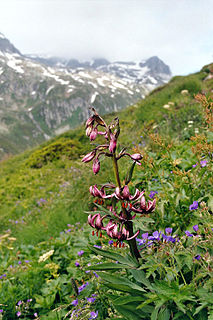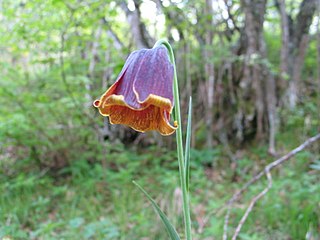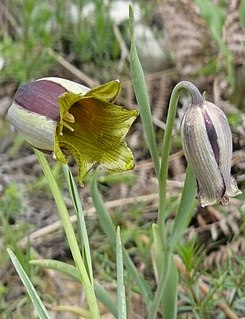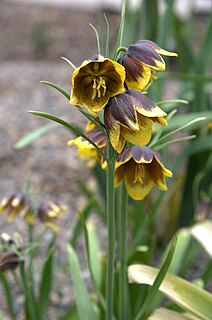
The Royal Horticultural Society (RHS), founded in 1804 as the Horticultural Society of London, is the UK's leading gardening charity.

Fritillaria imperialis, the crown imperial, imperial fritillary or Kaiser's crown, is a species of flowering plant in the lily family, native to a wide stretch from Kurdistan across the plateau of Turkey, Iraq and Iran to Afghanistan, Pakistan, Northern India and the Himalayan foothills. It is also widely cultivated as an ornamental and reportedly naturalized in Austria, Sicily, and Washington State, USA. The common names and also the epithet "imperialis", literally "of the emperor", refer to the large circle of golden flowers, reminiscent of an emperor's crown.

{{automatic taxobox | image = Fritillaria meleagris0.jpg | image_caption = Fritillaria meleagris | display_parents = 2 | taxon = Fritillaria | authority = Tourn. ex L. | synonyms_ref = | synonyms =

The lily family, Liliaceae, consists of about 254 genera and about 4075 known species of flowering plants within the order Liliales. They are monocotyledonous, perennial, herbaceous, often bulbous geophytes. Plants in this family have evolved with a fair amount of morphological diversity despite genetic similarity. Common characteristics include large flowers with parts arranged in threes: with six colored or patterned petaloid tepals arranged in two whorls, six stamens and a superior ovary. The leaves are linear in shape, with their veins usually arranged parallel to the edges, single and arranged alternating on the stem, or in a rosette at the base. Most species are grown from bulbs, although some have rhizomes. First described in 1789, the lily family became a paraphyletic "catch-all" (wastebasket) group of petaloid monocots that did not fit into other families and included a great number of genera now included in other families and in some cases in other orders. Consequently, many sources and descriptions labelled "Liliaceae" deal with the broader sense of the family.

Fritillaria meleagris is a Eurasian species of flowering plant in the lily family. Its common names include snake's head fritillary, snake's head, chess flower, frog-cup, guinea-hen flower, guinea flower, leper lily, Lazarus bell, chequered lily, chequered daffodil, drooping tulip or, in northern Europe, simply fritillary. The plant is native to the flood river plains of Europe where it grows in abundance.

The scarlet lily beetle, red lily beetle, or lily leaf beetle, is a leaf beetle that eats the leaves, stem, buds, and flowers, of lilies, fritillaries and other members of the family Liliaceae. It lays its eggs most often on Lilium and Fritillaria species. In the absence of Lilium and Fritillaria species, there are fewer eggs laid and the survival rate of eggs and larvae is reduced. It is now a pest in most temperate climates where lilies are cultivated.

Fritillaria persica is a Middle Eastern species of flowering plant in the lily family Liliaceae, native to southern Turkey, Iran, Iraq, Lebanon, Syria, Palestine and Israel. It is widely cultivated as an ornamental and naturalized in the Lazio region of Italy. It is the sole species in Fritillaria subgenus Theresia.

Fritillaria pyrenaica is a species of flowering plant in the family Liliaceae, native to the Pyrenees in Spain and France. Common names include Pyrenean fritillary and Pyrenean snake's-head. It is a bulbous perennial growing to 45 cm (18 in). The pendent, bell-shaped flowers are borne in spring. They have recurved tepals which are purple tinged with brown and yellow. Like other species in this genus, notably F. meleagris, they are strongly chequered.

Fritillaria pallidiflora is an Asian species of bulbous flowering plant in the lily family Liliaceae, native to Xinjiang, Kyrgyzstan and Kazakhstan. The common name frequently used is Siberian fritillary, a misnomer because the species does not grow in the wild in Siberia.

Fritillaria acmopetala, the pointed-petal fritillary, is a species of flowering plant in the lily family Liliaceae, native to rocky limestone mountain slopes in the Middle East. It was first described by Pierre Edmond Boissier in 1846.
Brian Frederick Mathew MBE, VMH is a British botanist, born in the village of Limpsfield, Surrey, England. His particular area of expertise is bulbous plants, particularly ornamental bulbous plants, although he has contributed to other fields of taxonomy and horticulture. He has authored or co-authored many books on bulbs and bulbous genera which appeal to both botanists and gardeners, as well as specialist monographs on other genera, including Daphne, Lewisia, and Helleborus. His work has been recognized by the British Royal Horticultural Society and the International Bulb Society.

Daphne pontica, commonly known as twin-flowered or Pontic daphne, is a species of flowering plant in the family Thymelaeaceae, native to Bulgaria, northern Turkey and the Caucasus. It is a small evergreen shrub growing to 1 m tall by 1.5 m wide, with leathery leaves and clusters of fragrant yellow flowers in pairs, in spring. The flowers are often followed by black berries. It tolerates deep shade in the garden, but dislikes transplanting.

Fritillaria michailovskyi is a species of flowering plant in the lily family, native to mountainous areas of northeastern Turkey. It is a bulbous perennial growing to 10–20 cm (4–8 in) tall, with narrow strap-shaped leaves and nodding umbels of distinctive, pendent, bell-shaped maroon flowers with yellow tips in spring.

Fritillaria gussichiae is a European plant species in the lily family, native to Bulgaria, North Macedonia, Serbia, Albania, and Greece.
Fritillaria kurdica is a Middle Eastern species of bulb-forming plants in the lily family, Liliaceae. It is native to Iran, Iraq, Turkey, and Caucasus. The species is sometimes cultivated in other regions as an ornamental.

Fritillaria gibbosa is a species of herbaceous perennial plant in the Liliaceae family. It is native to Afghanistan, Iran, Pakistan, Turkmenistan, and Transcaucasia.
Edward Martyn Rix is a British botanist, collector, horticulturalist and author. Following completion of a PhD on Fritillaria at Cambridge University, he worked in Zurich, Switzerland and at the Royal Horticultural Society gardens at Wisley. Hhe is the author of many books and articles on plants and horticulture and is the editor of Curtis's Botanical Magazine, based at the Royal Botanic Gardens, Kew in London.

Fritillaria sewerzowii is a perennial herbaceous bulbous plant, distributed in alpine areas of central Asia. It is a species in the genus Fritillaria, in the family Liliaceae. It is placed in the subgenus Korolkowia.

Fritillari japonica is a perennial herbaceous bulbous plant, endemic to Japan. It is a species in the genus Fritillaria, in the family Liliaceae. It is placed in the subgenus Japonica.

Fritillaria reuteri is a perennial herbaceous bulbous plant, distributed in Turkey and Iran. It is a species in the genus Fritillaria, in the family Liliaceae. It is placed in the subgenus Fritillaria.

















